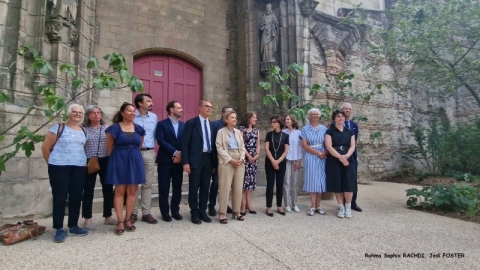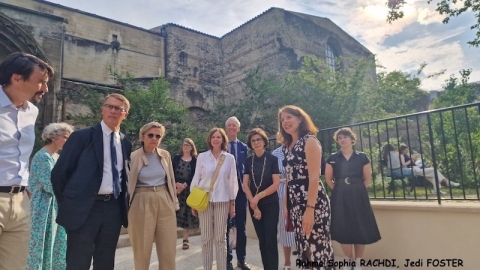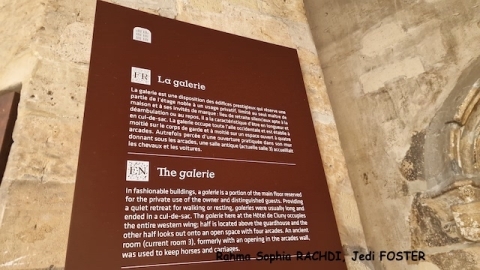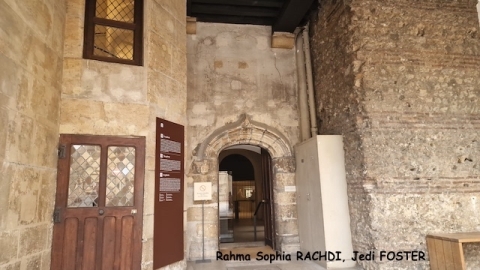Arts
FRENCH MIN OF CULTURE RACHIDA DATI INAUGURATES REBIRTH OF CLUNY MUSEUM GARDENS
WITH MAYOR OF PARIS 5, FLORENCE BERTHOUT

Medieval Museum Cluny, Paris (Source: Rahma Sophia Rachdi, Jedi Foster)
USPA NEWS -
This Friday, July 18, 2025, at 6:00 PM, under the glowing heat of a Parisian summer, Rachida Dati, France’s Minister of Culture, elegantly soberly dressed in black and gold, stepped into the historic 5th arrondissement to inaugurate the newly restored public garden of the Cluny Museum, nestled between the Gothic spires of history and the hum of the Latin Quarter.
At her side were Florence Berthout, Mayor of the 5th arrondissement, Patrick Bloche, First Deputy Mayor of Paris, and a few key patrons who helped bring the garden back to life. The delegation was warmly welcomed by Severine Lepape, Director of the Cluny Museum. The visit began around 6:30 PM with a peaceful walk through the refreshed outdoor spaces before the official reopening was announced by the Minister herself.
At her side were Florence Berthout, Mayor of the 5th arrondissement, Patrick Bloche, First Deputy Mayor of Paris, and a few key patrons who helped bring the garden back to life. The delegation was warmly welcomed by Severine Lepape, Director of the Cluny Museum. The visit began around 6:30 PM with a peaceful walk through the refreshed outdoor spaces before the official reopening was announced by the Minister herself.
A MEDIEVAL TREASURE REOPENS IN THE HEART OF PARIS, 5TH
After nine months of intensive renovation, the 4,000 m² garden, part of the National Museum of the Middle Ages is now open again to the public. This revival is the fruit of over a decade of planning and ambition by the museum’s team. And what a reward it is: the garden now offers shaded play areas for children, cool respite for families, and lush green spaces where history breathes and summer heat retreats under leafy trees. Reported by Rahma Sophia RACHDI, on site
After nine months of intensive renovation, the 4,000 m² garden, part of the National Museum of the Middle Ages is now open again to the public. This revival is the fruit of over a decade of planning and ambition by the museum’s team. And what a reward it is: the garden now offers shaded play areas for children, cool respite for families, and lush green spaces where history breathes and summer heat retreats under leafy trees. Reported by Rahma Sophia RACHDI, on site
Between November 2024 and July 2025, the garden underwent a full rehabilitation designed to make it not only more pleasant and immersive but also fully accessible to all visitors. The works carefully respected the historical significance of the site, while addressing modern needs such as climate resilience and inclusive design.
The project was overseen by the City of Paris, under the authority of the Ministry of Culture, and funded by the Cluny Museum with the support of Crédit Agricole Île-de-France Mecenat and the Crédit Agricole Foundation Pays de France. Notably, the visit lasted about an hour, and in the spirit of quiet elegance, no formal speeches were delivered, just smiles, conversation, and a final group photo before the press quietly dispersed.
The project was overseen by the City of Paris, under the authority of the Ministry of Culture, and funded by the Cluny Museum with the support of Crédit Agricole Île-de-France Mecenat and the Crédit Agricole Foundation Pays de France. Notably, the visit lasted about an hour, and in the spirit of quiet elegance, no formal speeches were delivered, just smiles, conversation, and a final group photo before the press quietly dispersed.
A GARDEN ROOTED INTIMATED. NOW REIMAGINED
Since 2014, nearly half the Cluny Garden had remained closed due to deteriorated wooden structures. With the completion of this major project, two-thirds of the total surface area, about 4,000 m², have now been restored and made accessible to the public. In a second phase, studies are underway to revive the final third: the historic garden of the Abbots of Cluny, once reserved for monastic reflection and soon to become part of the museum’s main visitor circuit.
Since 2014, nearly half the Cluny Garden had remained closed due to deteriorated wooden structures. With the completion of this major project, two-thirds of the total surface area, about 4,000 m², have now been restored and made accessible to the public. In a second phase, studies are underway to revive the final third: the historic garden of the Abbots of Cluny, once reserved for monastic reflection and soon to become part of the museum’s main visitor circuit.
WHERE MEDIEVAL HERITAGE MEETS MODERN SUSTAINABILITY
The Cluny Museum has embraced a bold yet respectful modernization, weaving historical inspiration with contemporary usage to welcome 21st, century visitors. The garden now features:
• A central promenade flanked by calm relaxation zones
• Planting beds subtly elevated to echo medieval garden layouts
• A botanical selection that mirrors plants once found in the Middle Ages, inspired by the museum’s famous “Lady and the Unicorn” tapestries
• A large lawn for relaxation, and improved pathway, some redesigned, others enhanced for access
The Cluny Museum has embraced a bold yet respectful modernization, weaving historical inspiration with contemporary usage to welcome 21st, century visitors. The garden now features:
• A central promenade flanked by calm relaxation zones
• Planting beds subtly elevated to echo medieval garden layouts
• A botanical selection that mirrors plants once found in the Middle Ages, inspired by the museum’s famous “Lady and the Unicorn” tapestries
• A large lawn for relaxation, and improved pathway, some redesigned, others enhanced for access
A playground shaded by trees has also been installed, including accessible wooden structures and spring-based games suitable for children and persons with reduced mobility.
A GREEN OASIS FACING CLIMATE CHANGE CHALLENGES
In the densely built fabric of central Paris, the garden stands as a true island of coolness. Officially designated a “Classified Wooded Area” in the city’s urban plan, the Cluny Garden is both a heritage site and a green lung. Newly planted species are native or regional, chosen for their resilience to extreme weather and commitment to biodiversity. The project was awarded the "UrbAdapt" label, recognizing its alignment with climate adaptation strategies supported by eco-conscious private sector partners.
In the densely built fabric of central Paris, the garden stands as a true island of coolness. Officially designated a “Classified Wooded Area” in the city’s urban plan, the Cluny Garden is both a heritage site and a green lung. Newly planted species are native or regional, chosen for their resilience to extreme weather and commitment to biodiversity. The project was awarded the "UrbAdapt" label, recognizing its alignment with climate adaptation strategies supported by eco-conscious private sector partners.
WHAT’s NEXT FOR THE CLUNY MUSEUM LEGACY FOR?
This renovation marks yet another milestone in the museum’s long-term transformation, begun in 2015. Still to come: restoration of the surrounding railings and completion of the final garden section, the historic cloister garden designed between 1498 and 1515.
Initially laid out as an extension of the abbot’s residence, the garden aligned with the private chapel. Though documentation is sparse, it likely mirrored the proportions of the museum’s forecourt (around 400 m²).
This renovation marks yet another milestone in the museum’s long-term transformation, begun in 2015. Still to come: restoration of the surrounding railings and completion of the final garden section, the historic cloister garden designed between 1498 and 1515.
Initially laid out as an extension of the abbot’s residence, the garden aligned with the private chapel. Though documentation is sparse, it likely mirrored the proportions of the museum’s forecourt (around 400 m²).
The 1855 Haussmannian reconfiguration expanded the space toward Boulevard Saint-Germain, reshaping it into a romantic open-air sculpture garden beloved by 19th-century Parisians.
In 2000, the garden was redesigned by landscape artists Ossart and Maurieres. Their medieval inspiration took center stage, though the garden remained outward-facing toward the boulevard. The current project, however, strives for balance: offering urban green space for today’s Parisians while reconnecting visitors to the medieval footprint of the original monastic garden.
In 2000, the garden was redesigned by landscape artists Ossart and Maurieres. Their medieval inspiration took center stage, though the garden remained outward-facing toward the boulevard. The current project, however, strives for balance: offering urban green space for today’s Parisians while reconnecting visitors to the medieval footprint of the original monastic garden.
THE NEW CLUNY MUSEUM GARDEN, A FEW NUMBERS
The newly reopened Cluny Garden covers a total of 3,990 square meters, nestled alongside the historic museum. Its ambitious transformation came at a cost of €1.35 million, funded primarily by the Cluny Museum’s own resources, with additional support from the City of Paris. (Source : Museum of Cluny)
The redesign includes 9 planting beds, laid out in a style inspired by medieval monastic gardens, and the planting of 6 new trees to enhance shade and biodiversity. Since 2017, the project has been backed by generous partners, Credit Agricole d’Île-de-France Bank, and the Credit Agricole Foundation, Pays de France, marking this garden revival as the final chapter in a decade-long renovation of the Cluny Museum’s estate. (source : Museum of Cluny)
The newly reopened Cluny Garden covers a total of 3,990 square meters, nestled alongside the historic museum. Its ambitious transformation came at a cost of €1.35 million, funded primarily by the Cluny Museum’s own resources, with additional support from the City of Paris. (Source : Museum of Cluny)
The redesign includes 9 planting beds, laid out in a style inspired by medieval monastic gardens, and the planting of 6 new trees to enhance shade and biodiversity. Since 2017, the project has been backed by generous partners, Credit Agricole d’Île-de-France Bank, and the Credit Agricole Foundation, Pays de France, marking this garden revival as the final chapter in a decade-long renovation of the Cluny Museum’s estate. (source : Museum of Cluny)
Liability for this article lies with the author, who also holds the copyright. Editorial content from USPA may be quoted on other websites as long as the quote comprises no more than 5% of the entire text, is marked as such and the source is named (via hyperlink).









